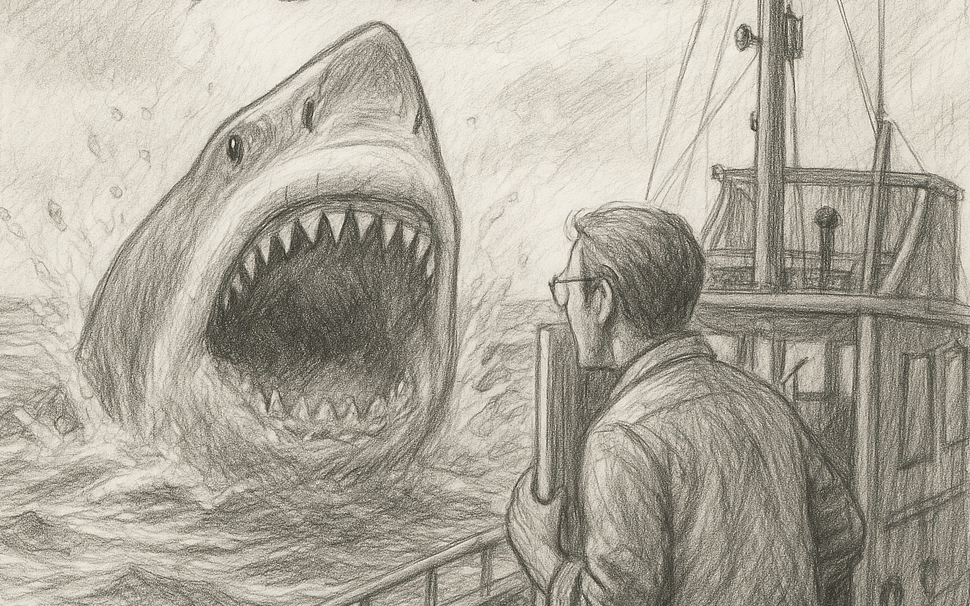Every year, like clockwork, I rewatch Jaws. It’s a ritual—part nostalgia, part admiration for Spielberg’s mastery. And this year, in honor of its 30th anniversary, I found myself inspired not just by the film’s suspense, but by something far more gameable: that iconic moment when the shark fully breaches the surface for the first time.
It’s not just cinematic. It’s instinctual. Brody sees the sheer size of it and backs into the cabin, stunned. No one says, “Well, maybe we can take it with enough harpoons.” No one rolls a skill check. They all know: this thing is out of their league.
And that got me thinking—why is that moment so hard to replicate in tabletop RPGs?
The Judgment Problem
In real life, we constantly assess threats based on experience and context. But in many RPGs, players are often flying blind. Unless the system explicitly supports power scaling or monster recognition, most players won’t know they’re outmatched until their characters are already halfway to the afterlife.
There’s even an unspoken social contract between players and storytellers: the assumption that the GM won’t throw something at them they can’t beat. But what happens when your story needs that encounter? When the villain must appear before the heroes are ready? Or when players retreat from a pivotal moment simply because they’re overly cautious?
Today, I want to dive into the murky waters of that design challenge—and explore ways to show, not tell, when something is too big to fight… or too weak to fear.
When They’re Out of Their Depth
Let’s start with the “bigger boat” moments: when the players face something well beyond their ability to handle. Some systems offer mechanics—lore rolls, knowledge checks—to give a sense of scale. But often, you don’t want to interrupt the moment with dice. You want that Sheriff Brody realization: the instinctive oh no that hits without needing to flip to page 213 of the rulebook.
Here are a few ways to pull that off:
1. Word of Mouth (Set the Stage Early)
Start laying the groundwork long before the encounter. The party hears tavern tales of a monster that decimated a battalion. A village elder speaks in hushed tones about “the red mist” that comes when the dragon flies overhead. These stories give players context and build dread.
2. What You See Is What You Get
Make the power level visually (or narratively) undeniable. The red dragon melts a city block with a single breath. The elder vampire casually disintegrates a castle guard with a whisper. The demon prince shrugs off a holy smite like a raindrop. Don’t just describe power—demonstrate it.
3. Show Its Inability to Be Harmed
A knight’s sword shatters on its hide. Spells fizzle before they connect. Siege weapons bounce off its armor. This sends a clear message: your current tools won’t cut it.
4. Use Parallels
Show powerful NPCs—ones the players respect or even fear—getting obliterated or backing down. If the renowned paladin is too terrified to fight the thing, maybe it’s not time for your level 4 rogue to rush in with dual daggers.
When They Should Stand and Fight
Just as dangerous as rushing headlong into a hopeless battle is the opposite: players running from something they could and should fight. Overcaution can stall a story just as much as reckless bravery.
To counter that, flip the same tools:
1. Word of Mouth (This Time, Encouraging)
Let the players hear stories of victory—like the mounted wyvern head above the tavern hearth, or the legend of a hunter who brought down the beast with just a spear and a prayer.
2. What You See Is What You Get
Have the creature actively engaged in battle when the party arrives. Maybe it’s losing. Maybe it’s wounded. Let them observe its limits.
3. Show It Can Be Hurt
“If it bleeds, we can kill it.” Have the party witness another character landing a hit. Show the creature make mistakes. These little cracks in the armor can give players confidence.
4. Parallels
If the town guard can hold it off, so can the party. If a pitchfork-wielding farmer drew blood, it’s not invincible. These analogies help frame the fight as winnable.
Visual Cues Aren’t Enough
Don’t rely solely on looks to convey power. RPGs defy appearances. A gargantuan red dragon is a threat—but so is the three-foot gnome wizard who just cast Time Stop and Meteor Swarm. And remember: not all threats look like threats. A vampire could look like a child. A death knight might be hidden in plain clothes.
Players need narrative context, not just visuals, to make informed decisions.
The Nuclear Option: Just Tell Them
Sometimes, the cleanest path is to break character and speak plainly: “Your character would know this creature is legendary for wiping out warbands.” Or, “You recognize that spell—this caster is way beyond your pay grade.”
It’s a little less cinematic, sure. But it preserves player agency—and that’s the core of good GMing. You want Milo the Fool to choose to fight the kraken, even if he’s wildly outmatched. You want his death (or narrow escape) to feel like his choice, not a gotcha.
Final Thoughts
Tension lives in the unknown—but dread and heroism both require context. Let players feel the thrill of realizing they’re out of their depth, and the satisfaction of knowing they can hold their own. Whether it’s a shark in the deep or a demon in the dark, the challenge is the same:
Give them enough to know when to run… and when to stand and fight.
Because sometimes, yeah…
You’re gonna need a bigger boat.






One Response
Slight correction, I meant the 50th anaversary of Jaws!